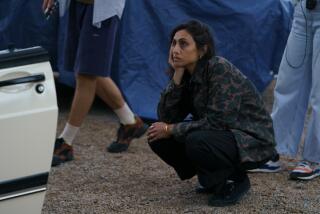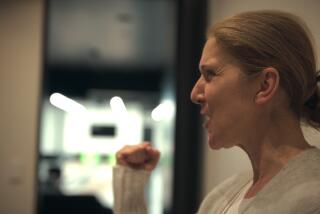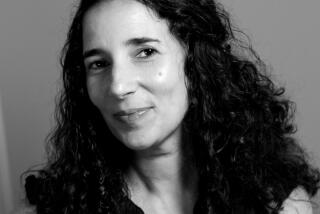Madeleine’s Daddy, the Human Video Camera
- Share via
Brian Hall may be the ultimate doting parent. When his daughter Madeleine was born in 1992, he didn’t document her early years merely by taking photographs, he chose to write a book.
“Certainly,” the 38-year-old author says of “Madeleine’s World” (Houghton Mifflin), an often minutely detailed rendering of the girl’s development from birth to age 3, “one of the challenges was to maintain some idea of where the line is between things that are fascinating and appealing to me because they’re about my child, and what they would be to the reader. I think probably that’s the biggest potential issue--that, in a way, writing this kind of book is like sitting people down with a long slide show about your kid.”
If such a comment makes Hall appear a little tentative, he readily acknowledges that this is true. The author of two travel books about Eastern Europe, as well as two novels--the better known of which, “The Saskiad,” (Houghton Mifflin) appeared this year--he is thoughtful, self-deprecating, surprised to have written a book about childhood when his original intention was to do nothing of the kind.
“I’ve kept a journal for years,” Hall says by phone from his home in Ithaca, N.Y., where he lives with his wife, Pamela, Madeleine and younger daughter Cora, 2. “And when Madeleine was born, I kept the same journal. But it was really just for my own memory, because I felt like I wanted to remember this.” As his relationship with Madeleine progressed, however, Hall began to rethink his point of view. “It was just before her third birthday,” he explains, “when she started asking me about my own early years. By this point, you’ve spent three years in very close connection with this kid, and you’ve got, in your own mind, what seems to be a rich and varied world. You’ve watched this development; after three years, you feel like there’s been a huge amount of progress. And then you realize: I don’t remember a thing of this part of my life. Nothing. And it’s kind of a shock that this is a world that really does disappear, at least in any kind of conscious way.”
“Madeleine’s World” is an attempt to remedy that failure of memory, to take Madeleine’s first three years and to preserve them in amber, as it were. From anecdotes about his daughter’s sleep patterns--she hates lullabies, it turns out--to discussions of books like “Pat the Bunny” that she likes read aloud, Hall seems to want to touch on everything, from the incidental to the profound. Given the book’s specific, almost insular, origins, it’s surprising the extent to which Hall’s experiences reflect those of other parents and their kids. In one memorable scene--which should resonate for anyone who has ever cared for a child--Madeleine makes the simple act of getting into a car seat an epic battle of wills.
“There’s something semi-universal about a lot of this,” Hall points out. “We know the universality of the very early things, like the swimming reflex, but to get a sense of the commonality, the human condition quality of a lot of the things that happen in the first three years is interesting to me.” That’s especially true when it comes to language acquisition, which, Hall believes, involves a nearly physical process of re-creating the world in sound.
Early on, for instance, he observes that Madeleine’s pronunciation of the word “chicken” sounds remarkably like a chicken’s cluck. “Watching Madeleine,” he says, “helped me understand just how much of our language is onomatopoeic. I had been aware of the old idea of words as sources of power, but until I saw her take in words and try to reproduce them, I didn’t have any visceral sense of why that might be. Part of the excitement was not just how this might relate to other children, but that I was seeing early childhood versions of the great human questions. Suddenly, it clicked for me.”
Such a process of reproduction, Hall notes, is hardly exclusive to language; rather, it is an essential feature of early childhood, when, with few tools of their own to interpret the chaos that surrounds them, kids look to parents and others for strategies to negotiate the world. On the most basic level, this is apparent in the tendency of young children to mimic, but, in Hall’s view, it goes deeper than that.
“I knew before we had Madeleine,” he remembers, “that kids are good imitators. But watching her take on gestures, opinions, whatever, really increased my appreciation of how personality is not only formed but constantly re-formed, the degree to which we borrow from the people around us.”
This has both positive and negative applications--while Hall writes with pleasure about Madeleine’s interest in reading and music, he also worries that she may have internalized his cautiousness, his tendency to hang back and approach situations with trepidation. “It’s an enormously complicated issue,” he says, “that raises the question of how much of what we learn starts off as rote, external stuff, which you can think of as an essentialist view of development, as opposed to a more existential one, when you take on the automatic response and have it eventually become part of your interior life because you act it out.”
Madeleine’s perceptions become more autonomous when she first becomes aware of mortality. Coming at around 3, Hall suggests, this is a key turning point in development, since it represents the child’s first encounter with the paradox of reason, the way that, despite the tantalizing pull of logic and order, “there are things that are not approachable in that way.” In this regard, Hall argues, it’s like a “clicking into place of some of the fundamental aspects of personhood,” which is one compelling reason to end the book when he does.
“With Madeleine,” he says, “the issue wasn’t just death, but animals, and how they kill each other. This was something she mulled over day after day after day, for weeks. It became her first realization of the problem of pain, which is a basic philosophical issue. This is it; it doesn’t get any greater than this. If there is a God, or any goodness, how do you deal with the existence of pain? And there’s no answer to any of it. So what she’s confronting for the first time is this irresolvable problem, which reminds you of the things you’re used to thinking about. It makes you see in a fresh way how painful all this is.”
In the end, this awareness of mortality may be a telling indicator of the emergence of consciousness, but now that “Madeleine’s World” is finished, Hall has no plans to record his daughter’s next three years. Instead, he says, he’s leaving Madeleine’s experiences to Madeleine, and turning his attention to other things. “When I first had this as a proposal,” he recalls, “I got an offer from one house to do a sequel from age 3 to 6. I’m not sure I would have done that anyway, but I knew right away that I didn’t want to do it because I would get into areas of Madeleine’s life that she would remember.”
Of course, Hall admits, “it’s too early to know whether I’m kidding myself and, in fact, she will be unhappy about this book, in which case I will regret having exposed her like that. But by stopping at the third year, I hoped I’d be dealing with a part of Madeleine’s life that she would never remember, so that when she reads the book later, it won’t seem like I’ve usurped her memories in any way.”
More to Read
Sign up for our Book Club newsletter
Get the latest news, events and more from the Los Angeles Times Book Club, and help us get L.A. reading and talking.
You may occasionally receive promotional content from the Los Angeles Times.











